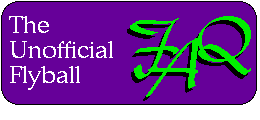|
|
Teaching the Exchange |
From: Jean Matushek (kjmatushek@mindspring.com)
Date:
Flyball Listserver
The 'method' I prefer for teaching inexperienced dogs to pass each other:
- The most important point! - make sure the dog has a reliable, motivated recall. Give the dog every reason to want to return to the handler as fast as possible. Use treats, toys, chase or tug games to get that dog focused and back to the handler. Hopefully, well before you even start with passing, you've done a lot of motivated recalls down the lane of jumps (ie. box to handler). Many people make the mistake of grabbing their dogs when they get to them, but please don't let "the game" end in such a manner. Praise and play with the dog to keep him excited about returning to you - don't just grab him and drag him back down to do another run (can be a big de-motivator....)
- Set up two racing lanes separated by baby gates and use a small section of the matting - several feet initially - and just practice motivated recalls with dogs running in opposite directions. Start out with one designated holder at each end holding a dog and instruct the owner/handlers to run down the lane to the opposite end and call their dogs, but not at the same time. Release the second dog only after the first has reached its owner. Some dogs will be distracted during the first couple of tries, but if you remember to keep this exercise fun and motivational, the focus falls into place. Some dogs will watch with great interest/concern as another dog comes racing in its general direction. Do not release these dogs until attention returns down the lane to its owner. If you release a dog whose head is turned toward another dog....simple physics: the body has to follow where the head is headed. Much better to wait the dog out and release it when his head is aimed at its handler. The "freedom" to run is its own reward. Only practice dogs in pairs to begin with until each dog indicates that it will be reliable in this particular phase.
- Once the dog shows that it is keen to return to its owner despite the presence of a running dog in the other lane, then you can practice simultaneous releases from opposite ends of the lanes so that the dogs are running in opposite directions at the same time ("passing" each other along the way). As long as the dogs remain focused on the recall, you can start to move the lanes closer together until you have them side by side.
- A totally separate exercise teaches the dogs "in line" to honor the dog that is running. The running dog practices its recall (again I prefer to use baby gates) while the "in line" dogs practice behaving themselves. Start with the "in line" dogs lined up about 10 - 15 feet away from but parallel to the "recall zone". They don't have to be on a sit stay or down stay, just behaving themselves (ie. not lunging at the running dog). After each recall, each "in line" dog that exhibits such self-control gets a quick release(after the runner has successfully run by) with praise and play and maybe even a treat and gets to take one step toward the lane. The barky lungey dogs need a little more work (try harder to focus the dog with treats or toys or whatever or increase the distance from the lane - remember, we don't want to worry the running dog...).
- Only when each of these exercises are mastered do we start to put them together. It does require a little preplanning to figure out how many holders you'll need on each end and in what order you'll need to line up. The beauty of it is that you can begin to work on passing from day one rather than waiting until the dogs are "doing flyball" before addressing the issue of passing.
Remember, dogs learn what they "practice" and if you let them "practice "lunging at other dogs, this will become a part of their game as they have come to understand it. If they practice the correct behaviors from the very beginning, that will become part of their game as they come to understand it.
Obviously not THE answer to passing. Just what I have come to support based on my experience. Also, just a quick summary; doesn't address every step in detail nor does it address the "Yeah, but what if..."s. And I still have people who will try to argue with me that training with gates is counterproductive (I won't argue - I'll just continue to do what works as long as it's fun for the dogs and their owners).
